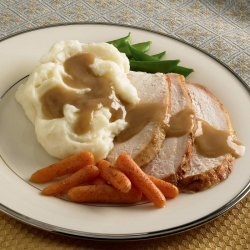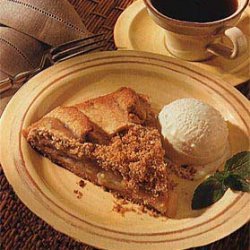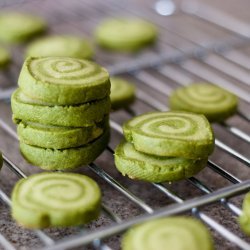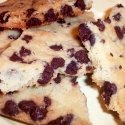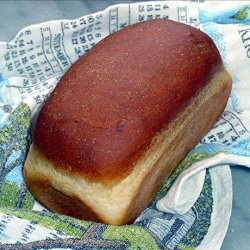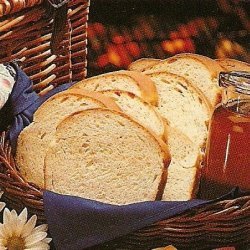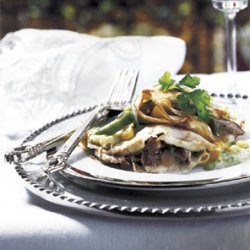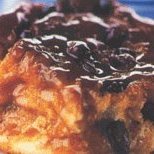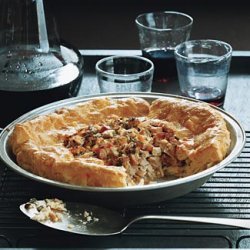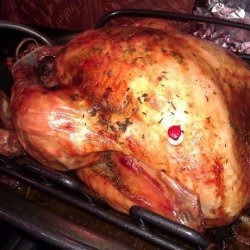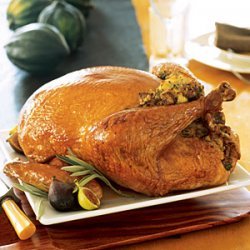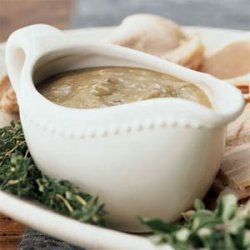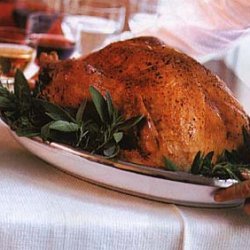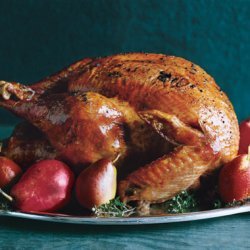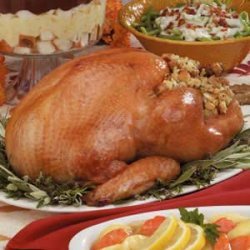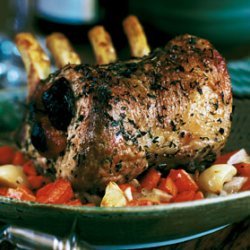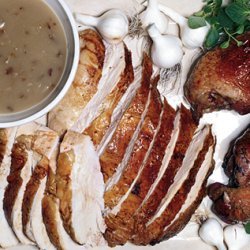Directions:
- Place oven rack in lowest position and preheat oven to 325°F. Butter 8-inch square baking dish or 2-quart casserole. Lightly brush roasting rack with vegetable oil and place in roasting pan.
- Remove plastic or paper packet of giblets from turkey (usually in small cavity). Remove from packaging and rinse; reserve gizzard and heart; discard floppy, dark purple liver. Remove neck from large cavity. Remove from packaging, rinse, and reserve. Using tweezers or needlenose pliers, remove any feathers and quills still attached to skin (kosher turkeys tend to require this more than others). Pull off and reserve any visible pale yellow knobs of fat from either side of tail (not found on all birds).
- Rinse turkey inside and out with cold water and pat dry. Loosely fill small (neck) cavity with stuffing. Fold neck skin under body and fasten with metal skewer. Loosely fill large body cavity with stuffing. Transfer remaining stuffing to buttered dish and drizzle with 1/4 cup stock. Cover with aluminum foil and refrigerate until ready to bake.
- Transfer turkey, breast-side up, to rack in roasting pan. Tuck wing tips under breast and tie drumsticks loosely together with kitchen string. Rub turkey all over with softened butter and sprinkle with 1 teaspoon salt and 1/2 teaspoon pepper. Tightly cover breast area with foil, leaving wings, thighs, and drumsticks exposed.
- Transfer gizzard, heart, neck, and reserved turkey fat to roasting pan around rack. Pour 2 cups stock into pan.
- Roast turkey 45 minutes. Baste with pan juices (lift up foil to reach breast area) and continue roasting, basting every 45 minutes, 1 1/2 hours more (2 1/4 hours total). Baste again and, if pan juices have evaporated into glaze, add 1 cup stock to pan. Roast another 45 minutes (3 hours total). Remove foil from breast area, baste, and add stock if necessary, until instant-read thermometer inserted into fleshy part of thigh (close to but not touching bone) registers 180°F, about 1 hour more (4 hours total).
- Insert instant-read thermometer into center of stuffing in body cavity. If thermometer does not read 165°F, transfer stuffing to microwave-safe baking dish and microwave on high until 165°F, about 3 minutes for 10 degrees. Cover and keep warm. Using turkey holders (or by inserting large metal serving spoon into body cavity), transfer turkey to large serving platter. Let stand 30 minutes before carving.
- Meanwhile, bake extra stuffing and make gravy: Raise oven temperature to 350°F. Remove giblets and neck from roasting pan and discard. Pour pan juices into measuring cup or gravy separator. Let stand until fat rises to top, 1 to 2 minutes, then skim off and reserve fat or, if using separator, carefully pour juices into measuring cup, reserving fat left in separator.
- Transfer foil-covered dish of extra stuffing to oven and bake 10 minutes. Meanwhile, add enough remaining stock to pan juices to total 4 cups. Measure turkey fat, adding melted butter if necessary to total 6 tablespoons. Straddle roasting pan across 2 burners on moderate heat and add fat. Whisk in flour, scraping up browned bits on bottom of pan, then cook, whisking constantly, 1 minute. Whisk in pan juicestock mixture and bring to a boil, whisking often. Reduce heat to moderately low and simmer, whisking occasionally, until gravy thickens, about 5 minutes. Whisk in remaining 3/4 teaspoon salt and 1/2 teaspoon pepper and keep warm. (Gravy can be kept warm over very low heat, covered, up to 20 minutes. If it thickens, thin with additional stock before serving. If skin forms on top, whisk well to dissolve.)
- When extra stuffing has baked 10 minutes, remove foil and bake, uncovered, until heated through, about 10 minutes. Pour gravy through fine-mesh sieve into large bowl, then transfer to gravy boat. Carve turkey and serve gravy and stuffing alongside.
- Test-Kitchen Tips: To combat dryness, most frozen turkeys and some fresh are injected with a saline solution. This is not a good thing, though: Injected birds generally lack flavor and can have a mushy texture. For this reason, we recommend buying a fresh turkey and checking the label to be sure there aren't any additives. (Look for the words all natural. ) Don't be too concerned, though, with the many other terms that can be applied to turkeys, such as free-range, organic, or heritage. All can be excellent.
- When buying a fresh bird, be sure to purchase it no more than two days before Thanksgiving. If you must get a frozen bird, defrost it in the refrigerator in a pan to catch drips, allowing a full 24 hours for each 5 pounds.
- Warm, moist stuffing is an optimal environment for bacteria such as salmonella or E. coli to multiply, so it's important to follow safe procedures. Be sure to make the stuffing at the last minute so it can go into the bird warm. This helps it move above the danger zone (the optimal temperature range for bacteria growth) more quickly during roasting. When you remove the turkey from the oven, be sure to check the temperature in the middle of the stuffing to make sure it's 165°F, the temperature at which bacteria will be killed. If it's not 165°F, scoop it out of the cavity and microwave it as directed in the recipe.
- More stuffing tips: Be sure not to overpack the cavities, as the stuffing will expand during cooking. Loosely fill the turkey, then spread the extra in a casserole dish (no more than 2 inches deep) and bake it after the turkey comes out (be sure to refrigerate it until then to impede bacteria growth). Drizzle the portion in the casserole dish with extra stock to make up for the juices it won't get from the turkey. If you want the stuffing that's cooked inside the turkey to be extra-moist (as opposed to having a crisp crust where it's exposed), cover the exposed portion with a small piece of aluminum foil.
- Opinions vary on whether or not to stuff the birdsome people think it can cause uneven cooking. For more on the subject, see our turkey primer. If you prefer not to stuff your bird, fill the cavities with a chopped vegetable and herb mixture that will impart its flavor to the meat and pan juices: Chop 1 onion, 1 celery rib with leaves, 1 carrot, and 3 tablespoons fresh parsley. Mix this with 1 teaspoon each dried rosemary, sage, and thyme. Sprinkle the cavities with salt and freshly ground black pepper and place the mixture inside. An unstuffed bird will take about 15 minutes to a half hour less to cook than a stuffed bird. When the turkey is cooked, tilt it to allow any juices that have collected in the cavity to drain into the pan. Do not serve the vegetable mixture, as it may not have cooked to a safe temperature.
- This recipe can easily be scaled up to serve more people. Estimate about 1 to 1 1/2 pounds per person. Cooking times (for a stuffed bird, cooked at 325°F to an internal temperature of 180°F) will be as follows: 8 to 12 pounds: 3 to 3 1/2 hours 12 to 14 pounds: 3 1/2 to 4 hours 14 to 18 pounds: 4 to 4 1/4 hours 18 to 20 pounds: 4 1/4 to 4 3/4 hours 20 to 24 pounds: 4 3/4 to 5 1/4 hours
- Some experts prefer to cook their turkeys to an internal temperature of 170°F (rather than 180°F, as in this recipe). If you don't mind having the meat slightly pink, this is perfectly safe and makes it more moist. However, Rick Rodgers, who created this recipe, believes that the dark meat in particular does not achieve its optimum flavor and texture until it reaches 180°F. If you choose to stuff your turkey and cook it to only 170°F, its stuffing will almost definitely not reach the safe temperature of 165°F. When you remove the turkey from the oven, be sure to check the temperature in the center of the stuffing, and if necessary remove it and microwave it as directed in the recipe.
- Letting the turkey stand for half an hour after it comes out of the oven is an essential part of the roasting process. When meat roasts, its juices move to the outer edge of the flesh. Letting it rest gives the juices time to redistribute, making for a moister turkey. An added bonus: The resting time provides an excellent window of opportunity to make the gravy and reheat the side dishes. There's no need to cover the birdit'll stay warm enough, and covering it would only soften the crispy skin.
Nutrition Facts
| Amount Per 1 Serving | |||
| Calories | 506.38 Kcal (2120 kJ) | ||
| Calories from fat | 443.02 Kcal | ||
| % Daily Value* | |||
| Total Fat | 49.22g | 76% | |
|---|---|---|---|
| Cholesterol | 162.29mg | 54% | |
| Sodium | 578.52mg | 24% | |
| Potassium | 146.92mg | 3% | |
| Total Carbs | 4.46g | 1% | |
| Dietary Fiber | 0.18g | 1% | |
| Protein | 13.62g | 27% | |
| Vitamin A | 0.6mg | 19% | |
| Iron | 0.6mg | 3% | |
| Calcium | 21mg | 2% | |
| Amount Per 100 g | |||
| Calories | 420.71 Kcal (1761 kJ) | ||
| Calories from fat | 368.07 Kcal | ||
| % Daily Value* | |||
| Total Fat | 40.9g | 76% | |
|---|---|---|---|
| Cholesterol | 134.83mg | 54% | |
| Sodium | 480.64mg | 24% | |
| Potassium | 122.06mg | 3% | |
| Total Carbs | 3.7g | 1% | |
| Dietary Fiber | 0.15g | 1% | |
| Protein | 11.32g | 27% | |
| Vitamin A | 0.5mg | 19% | |
| Iron | 0.5mg | 3% | |
| Calcium | 17.4mg | 2% | |
* Percent Daily Values are based on a 2000 calorie diet. Your daily values may be higher or lower depending on your calorie needs.
Find out how many calories should you eat.
Get Your Recipe of Health!
Follow RecipeOfHealth on Facebook!


